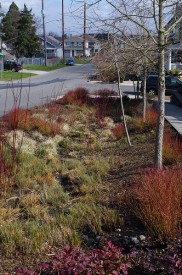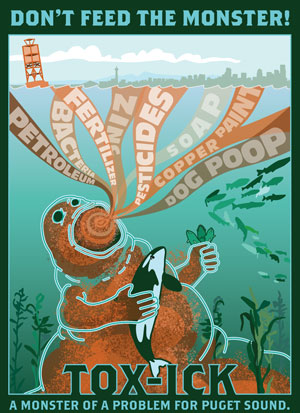We recently updated you on the new stormwater permits that will soon dictate how Washington State’s most populated areas manage polluted runoff that damages water quality and can flood low-lying property. Here we’ll tackle the new Phase II Municipal Stormwater Permit, which covers the next most populated areas and affects nearly 100 cities around the state.
These cities are legally obligated to try to control water that runs off pavements, roofs and streets in built areas every time it rains. Along the way, that water picks up toxic metals, motor oil, lawn fertilizers, animal droppings, and a cocktail of other pollutants before it washes into local waterways and oceans. The rules governing how cities and other jurisdictions manage this dirty runoff are contained in municipal permits, which were recently updated in Washington State and are about to kick in throughout much of the state.
There are actually two Phase II Municipal Stormwater Permits: one for western Washington and one for eastern Washington. That’s because each side of the state has very different climate conditions, soils, and geology, which are important considerations when thinking about how water moves around.
The Western Washington Phase II Municipal Stormwater Permit, which goes into effect on August 1, 2013, covers 80 medium and small cities and the urban portion of four counties. The Eastern Washington Phase II Municipal Stormwater Permit, which takes effect one year later, covers 18 cities and urban areas in six counties. Both will remain in effect for five years.
As you may imagine, there are significant differences between two region’s Phase II permits. In particular, the new low-impact development (LID) regulations are very different. So let’s take a look at each permit in turn.
Western Washington Phase II Municipal Stormwater Permit

The new western Washington permit contains important new requirements in three areas:
- New watershed-scale stormwater planning requirements
- New monitoring and assessment requirements
- New low-impact development (LID) requirements
The first major change is based on the concept that many pollution and flooding problems are best addressed at the watershed level. That wider focus also helps identify the most cost-effective pollution control strategies to meet clean water goals. The watershed planning process, outlined in an earlier post, requires Phase II permittees to work with counties and other municipalities in the watershed. After pulling together water quality data, flow records, biological baselines, and zoning maps, they must collectively develop strategies to change land use plans and development codes in ways that can manage polluted runoff more effectively.
The second major change involves the new Regional Stormwater Monitoring Program (RSMP) that will collect information on water quality, habitat, and biota in the Puget Sound basin; conduct regional studies of stormwater practices; and develop a public information repository. Permittees can either pay to participate in the regional program or comply with individual monitoring requirements on their own. The benefit of the RSMP is that it will provide a comprehensive approach to monitoring in the Puget Sound basin (think economies of scale).

The third major change involves low-impact development that works with nature to manage stormwater as close to its source as possible, rather diverting it into pipes or large collection areas. LID techniques include bioretention facilities (think engineered rain gardens), vegetated rooftops, rain barrels, French drains, and permeable pavement that allows water to soak through rather than run off hardscapes. These tools reduce the impact of built areas on local water bodies and help water move more naturally through an ecosystem or watershed.
Phase II permittees have to incorporate LID standards into their development codes by December 31, 2016 (except for newly added permittees, who have an extra year to comply). Once those are in place, builders and landowners will be required to consider and use low-impact development best management practices (BMPs) when they’re developing or redeveloping land. The process is detailed in Appendix 1 to the Western Washington Phase II permit. Depending on the size of the project, where it’s located, and where runoff winds up, builders must work from one of two lists of recommended low-impact development practices. The developer must consider each BMP on the list, in the order listed, and use the first one that is feasible.
Or, some developers have a second choice. Rather than using the specific LID techniques on the list, some projects can instead elect to meet a LID Performance Standard that compares pre-development stormwater flow rates to post-development flow rates and sets standards that the project must meet.
Finally, another important change is that the new Western Washington Phase II permit requires that certain standards apply to sites less than one acre. The prior version exempted new development, redevelopment, and construction sites that disturbed less than one acre of land. That exemption has been removed.
Eastern Washington Phase II Municipal Stormwater Permit
The eastern Washington permit differs in two main areas—monitoring and low-impact development. In particular, the LID requirements for eastern Washington are wholly different than the requirements for western Washington.
They’re less evolved, in the sense that they’ll be phased in. The eastern Washington permit requires that initial steps be taken to implement low-impact development techniques. By December 31, 2017, for instance, eastern Washington permittees must require certain projects to retain runoff on-site or in regional facilities allowing it to percolate into the ground, or to develop feasibility criteria that factor in local conditions like soils that are too poor to let runoff soak in.
The new monitoring requirements for the Eastern Washington Phase II permittees require them to work together on studies that evaluate stormwater management programs. The hope is to start gathering basic information that will improve the permittees’ programs and future permit requirements.
In addition, the Washington Department of Ecology is working with eastern Washington permittees to develop a low-impact development manual for that side of the state. The state agency is also planning to support low-impact development research in eastern Washington, training for local government staff and contractors, and education to expand the use of LID practices.
So that’s the landscape for Washington’s municipal stormwater permits through 2018. That is, if the permits aren’t changed due to pending legal appeals.
Ashley Pedersen is an environmental attorney and policy analyst who lives in Seattle.


Comments are closed.